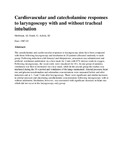| dc.contributor.author | Shribman, AJ | |
| dc.contributor.author | Smith, G | |
| dc.contributor.author | Achola, KJ | |
| dc.date.accessioned | 2013-06-12T07:58:18Z | |
| dc.date.available | 2013-06-12T07:58:18Z | |
| dc.date.issued | 1987-03 | |
| dc.identifier.citation | Br J Anaesth. 1987 Mar;59(3):295-9. | en |
| dc.identifier.uri | http://www.ncbi.nlm.nih.gov/pubmed/3828177 | |
| dc.identifier.uri | http://erepository.uonbi.ac.ke:8080/xmlui/handle/123456789/32031 | |
| dc.description.abstract | The catecholamine and cardiovascular responses to laryngoscopy alone have been compared with those following laryngoscopy and intubation in 24 patients allocated randomly to each group. Following induction with fentanyl and thiopentone, atracurium was administered and artificial ventilation undertaken via a face mask for 2 min with 67% nitrous oxide in oxygen. Following laryngoscopy, the vocal cords were visualized for 10 s. In one group of patients, ventilation was then re-instituted via a face mask, while in the second group the trachea was intubated during the 10-s period and ventilation of the lungs maintained. Arterial pressure, heart rate and plasma noradrenaline and adrenaline concentrations were measured before and after induction and at 1, 3 and 5 min after laryngoscopy. There were significant and similar increases in arterial pressure and circulating catecholamine concentrations following laryngoscopy with or without intubation. Intubation, however, was associated with significant increases in heart rate which did not occur in the laryngoscopy-only group. | en |
| dc.language.iso | en | en |
| dc.publisher | University of Nairobi, | en |
| dc.title | Cardiovascular and catecholamine responses to laryngoscopy with and without tracheal intubation | en |
| dc.type | Article | en |
| local.publisher | School of Medicine, University of Nairobi | en |

